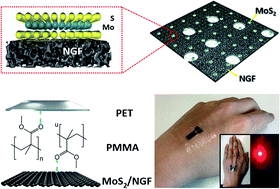Ultrathin MoS2 flakes embedded in nanoporous graphene films for a multi-functional electrode†
Abstract
Molybdenum disulfide (MoS2) is considered a promising material in energy storage systems, and is thus drawing considerable attention. However, the relatively low conductivity of bulk MoS2 has been a threat for practical applications. This study developed a simple and scalable fabrication method of few-layer MoS2 sheets embedded in a nanoporous graphene film (NGF) as a high capacitance active material. Transfer of MoS2/NGF onto a flexible substrate followed by plotter cutting produced a highly efficient micro-supercapacitor with superior flexibility, mechanical stability, and great potential for applications in wearable electronics. Notably, MoS2/NGF-based mSC revealed a high volumetric capacitance of 55 F cm−3 and 82.2% of capacitance retention after 20 000 cycles, which are superior to the reported data for solid-state micro-supercapacitors. With these performances, the flexible MoS2/NGF mSC exhibited an ultrahigh energy density of 7.64 mW h cm−3 and power density of 9.96 W cm−3 in a H3PO4 gel polymer electrolyte. The high volumetric capacitance and energy/power densities of MoS2/NGF as micro-supercapacitor electrodes are due to direct growth of ultra-thin MoS2 onto the interconnected 3D nanoporous graphene film with extended active sites and good conductivity. The MoS2/NGF mSC integrated on the skin efficiently powered a light emitting diode and strain sensors. This work suggests a meaningful way to realize film type MoS2 active materials in flexible micro-supercapacitors for wearable applications.

- This article is part of the themed collection: Journal of Materials Chemistry A Lunar New Year collection 2022


 Please wait while we load your content...
Please wait while we load your content...